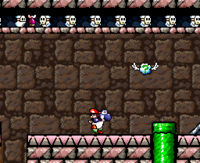Relay Heihō
The title of this article is official, but it comes from a non-English source. If an acceptable English source is found, then the article should be moved to its appropriate title.
Relay Heihō are bomb-dropping Boo Guys from Super Mario World 2: Yoshi's Island, Yoshi's Island: Super Mario Advance 3, and Yoshi's New Island.
History
Super Mario World 2: Yoshi's Island

In Super Mario World 2: Yoshi's Island, they are found stationed in long rows within the ceilings of certain castles. They relay a single purple bomb, dropping it when a Yoshi approaches them. The Yoshi can perform a Ground Pound to force them to drop the bomb. If they miss, the one who dropped it will hang its head with an ashamed expression, with them starting over a few moments later. Due to their position, they cannot be defeated.
Yoshi's New Island
In Yoshi's New Island, Relay Heihō act the same, though they no longer change expression when the Yoshi ground pounds; the game has unused textures for those expressions in its data.[citation needed]
Names in other languages
| Language | Name | Meaning |
|---|---|---|
| Japanese | ゆーれいヘイホー[1] Yūrei Heihō リレーヘイホー[2] Rirē Heihō |
Yūrei Shy Guy; same as Boo Guy (Super Mario: Yossy Island) Relay Shy Guy (Yoshi's New Island) |
References
- ^ 「食べてからはき出せば、コロコ口転がって敵をまとめて倒せる。天井に並んでバケツリレーのように爆弾を運び、投下するものもいる。」 ("If spat after eating, they roll and can defeat enemies at once. Some also line up in the ceiling like a bucket relay to transfer a bomb, and drop it.") - 「スーパーマリオアドバンス3任天堂公式ガイドブック」 (Super Mario Advance 3 Nintendo Kōshiki Guidebook), page 23.
- ^ 「ヨッシー New アイランド 任天堂公式ガイドブック」 (Yoshi's New Island Nintendo Kōshiki Guidebook), page 26.